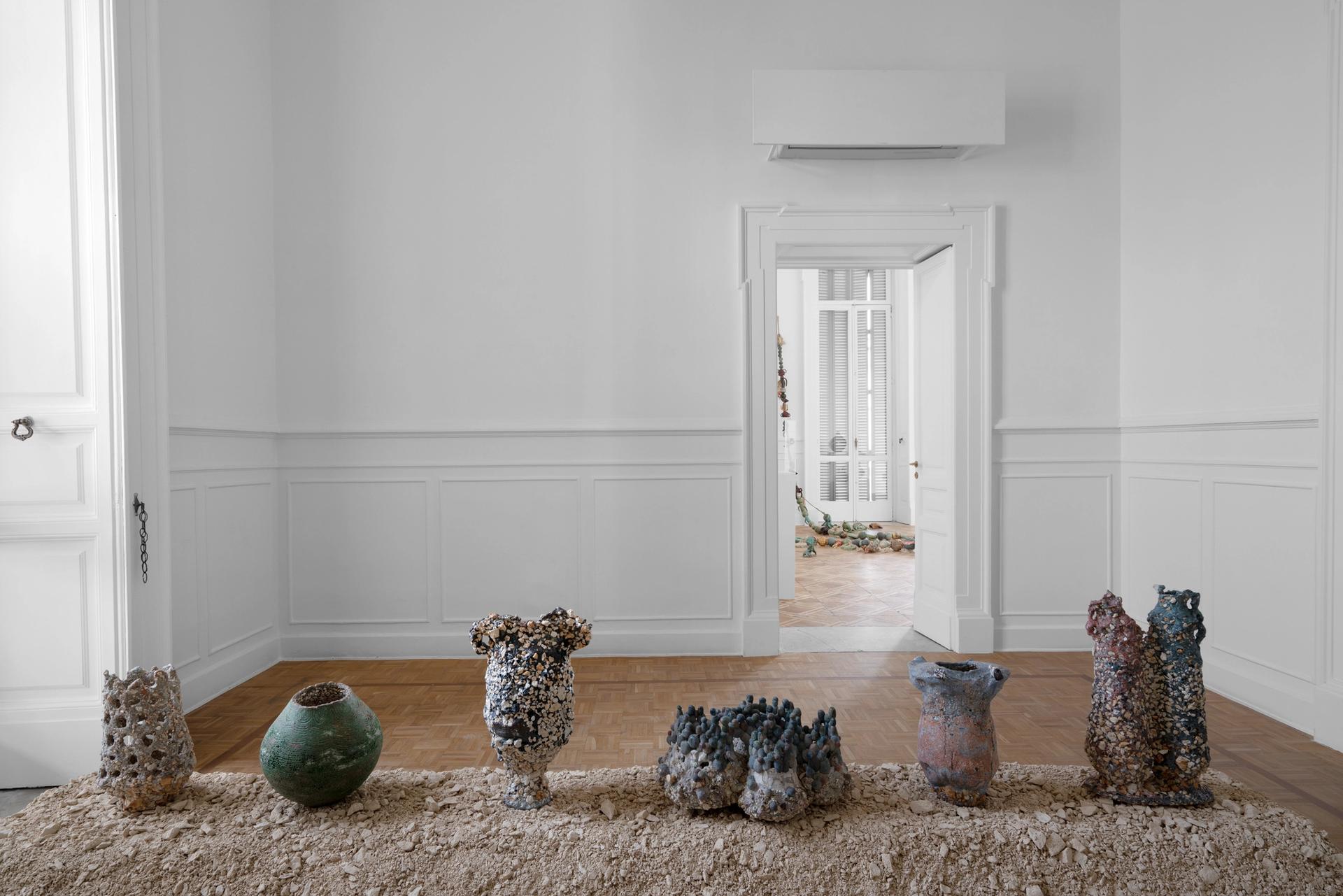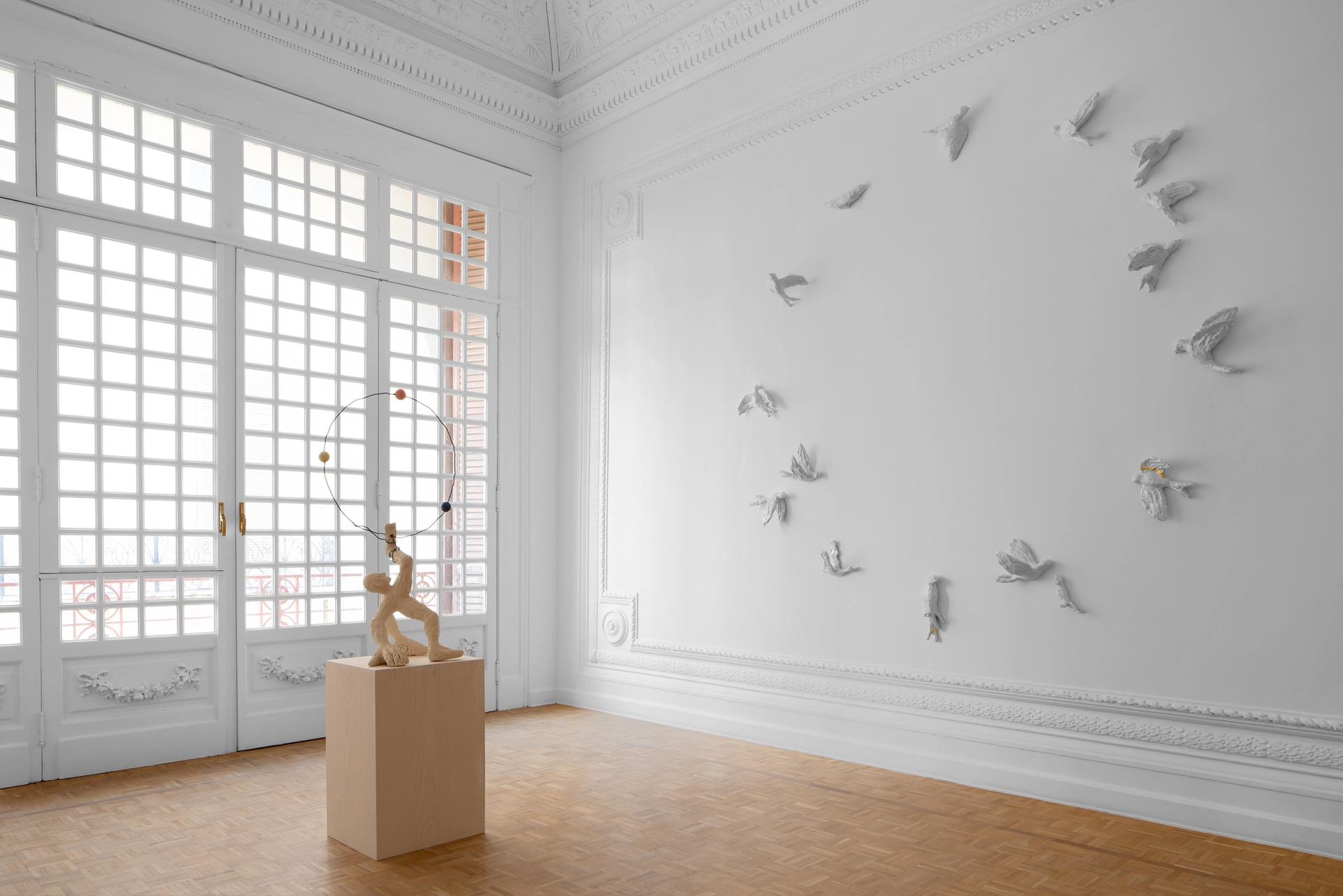Ceramics are all the art world rage at the moment, but a new exhibition at Thomas Dane's Naples gallery is one apart. Postponed twice due to Covid, A Matter of Life and Death, bring together an international line up of 13 artists who have made works in clay.
Organised by curator Jenni Lomax, it feels more like an institutional show than a commercial one—although it features a formidable quartet of artists on the gallery's roster: Magdalene Odundo, Lynda Benglis, Anya Gallaccio and the late Philip King. For 27 years, Lomax was the pioneering director of Camden Art Centre where, long before today’s upsurge in interest, she established a reputation for championing work in ceramics as well as the best in contemporary and 20th-century art. During her time at Camden she instigated a programme of ceramics fellowships and her departure was marked by the gallery’s establishment of The Freelands Lomax Ceramics Fellowship, which continues to offer residencies and exhibition opportunities to emerging artists working with clay.
This abiding commitment to the history and potential of ceramics is evident in Lomax’s choice of work for Thomas Dane, which spans generations and pushes at the limits of what clay can be made to say and do. A trio of sleek new burnished pots by Magdalene Odundo is offset by a pieced painted terracotta plaque by Lucio Fontana; Philip King sliced vessel sculptures cavort alongside two totemic perforated standing structures etched with English and Yoruba text from Lawson Oyekan; and in Keith Harrison’s film, clay is wrapped directly around the elements of his grandmother’s electric fire to potentially lethal effect.
Serena Korda’s grimacing, anthropomorphic pots are designed to be blown into while Anya Gallaccio’s amorphous forms have been recycled from an earlier work in which raw clay was robotically shaped using a 3D printer. Part bones, part intestines, these suggestive shapes are now given a new glazed, patinated lease of life by being ceremonially cremated in both industrial and outdoor, wood-fuelled kilns.

Artwork: Masaomi Yasunaga. Courtesy the artist, Thomas Dane Gallery and Nonoka Hill. Photo: Maurizio Esposito
More clay rituals are conjured up in the mysterious encrusted structures of Masaomi Yasunaga, which are fired by being buried in sand mixed with fragments of pebbles, glass and ash. (Once Yasunaga even added the ashes of his grandmother.) These bizarre forms, some resembling corals, others barnacled artefacts taken from the ocean floor, are here shown lined up along a funerary mound of the mineral detritus out of which they originally emerged. Phoebe Cummings’ took up residence in the gallery in order to create her intricate and impossibly delicate arrangements of flowers and fruit that resemble Flemish vanitas paintings, and which, being fashioned from unfired clay, are also destined to perish over time. Another memento mori is offered by Chiara Camoni’s vases, which are exuberantly adorned with the seductive but also malevolent forms of butterflies, and then filled with cut blooms which, rather than being replaced, arejust allowed to wither and die.
The presiding genius of A Matter of Life and Death is the great Argentinian-Italian artist and theorist Lucio Fontana, whose perforated, gouged or vigorously modelled ceramic works are positioned throughout the exhibition, starting with a punctured egg-like terracotta sphere in first room. Fontana arrived in Italy as a small child at the beginning of the 20th century, just at the same time as a series of violent earthquakes devastated the country. This eruptive quality fed directly into his ceramic work where he made piercings and slits into clay, as well as his better known holes and cuts into canvas. Fontana’s revelling in the properties and processes of clay sets the tone for this exhibition, and his description of his ceramic works as “terremotata ma firma” (earthquaked but motionless) could also have been its title.
Instead, A Matter of Life and Death is named after the classic 1946 Powell and Pressburger film in which a World War 11 fighter pilot, played by David Niven, bales out of his plane and finds himself neither alive nor dead. Suspended in a limbo place between these two states, he has to bargain for his life, in a place somewhere between heaven and hell. Similarly it is the uncertain status of clay, encompassing both fragility and strength, beauty and abjection, that is the central theme of the show. The stuff of the earth, ceramics are shaped, fashioned but also frequently destroyed by the water and fire that give them their form. Both resilient and delicate, works made from clay can survive in all climates for millennia, but also be shattered by a misfiring or a chance topple. At every stage, as everyone working with ceramics knows, the potential for catastrophe is never far away.

Artwork: Andrew Lord. Courtesy the artist, Gladstone Gallery and Thomas Dane Gallery. Photo: Maurizio Esposito
So what better setting for this exploration of elemental, existential precarity than Naples, a city stacked around a watery bay and presided over by a volcano? A place of beauty and resilience, it is redolent of death and drama: below the streets is a maze of underground catacombs piled with the bones of the dead and even the bollards are topped by skulls. Roofed with clay, floored with terracotta, Naples is also the home of Capodimonte porcelain. It bristles with archaeological, anthropological and ceramic wonders, and the drama, atmosphere and instability of this ancient and often violent city infuses every work in this exhibition.
This Neapolitan setting highlights the lava-like quality of Anya Gallaccio’s squirming lustrious forms, it gives Lynda Benglis’ shimmying strips and slabs of brilliantly glazed clay assume a baroque curvaceousness and accentuates the association of Philip King’s sculptures with classical vases, jugs and pitchers, at the same time as they strike human poses with their bulbous bellies, angular handles andprotruding spouts. A more contained energy is to be found in the poised pots of Magdalene Odundo which also nod to the vessels exhumed from Pompeiian ash as they hover perilously en pointe on their plinths, their surfaces smoked with the patterning of repeated firings.
Sometimes a sense of destruction is built into the work itself. Andrew Lord’s wall-mounted circle of sixteen soaring swallows flaunt the breakages to their wings and tails in golden seams of Japanese kintsugi repair; while the dusty pile of destroyed blooms lying below Phoebe Cummings’s sumptuous floral sconce is all that is left of the earlier version that unexpectedly fell to the floor, dramatically foretelling the ultimate fate of the current piece once the ambient temperature has caused all its unglazed leaves and petals to crumble into dust. Cummings’ works are not supposed to survive this show: another even more intricate unfired clay confection slowly oozes a trickle of water that will ultimately melt all its intricate detail into a muddy mass .
Thomas Dane Gallery overlooks the bay of Naples and this volatile watery ambience also makes its presence felt. Serena Korda makes direct reference to the dramatic vista in a gigantic ceramic necklace made especially for this show. Draped across doors and spilling onto the floor, it is strung with huge decorative baubles in the shape of exotic fruit, as well as sweeping, double-faced weeping mermaid’s head which apparently refers to the mythological sirens that tempted sailors from their boats. Breaking away from this chain are a series of grotesque severed ceramic hands and tentacled creatures that seem to be scuttling across the floor towards a lively pouting fish by Lucio Fontana.
The baroque grotesquery and ornament-overload of Naples finds more echoes in Korda’s other series of big-bellied ceramic and stoneware bottles which have bearded—and in one case vomiting—faces and surfaces that variously sprout multiple breasts, atom-bomb clouds and a vaginal gash. Contrary to their appearance, these excessive, suggestive vessels are designed to contain not liquids but air, and they sit, waiting to be blown into and activated as part of Korda’s "jug orchestra".
But while this particular orchestra may be silenced there is no shortage of animation in this dynamic, vibrant exhibition. In Jenni Lomax’s hands, clay is yet again confirmed as both a timeless and a timely medium, and especially in this dramatic city which teems with both life and death. But whether in Naples or beyond, this parade of marvellous, multifarious ceramics offers a powerful and unsettling metaphor for our current volatile times where nothing is fixed, static or certain.
• A Matter of Life and Death, Thomas Dane Gallery, Naples, until 28 May


